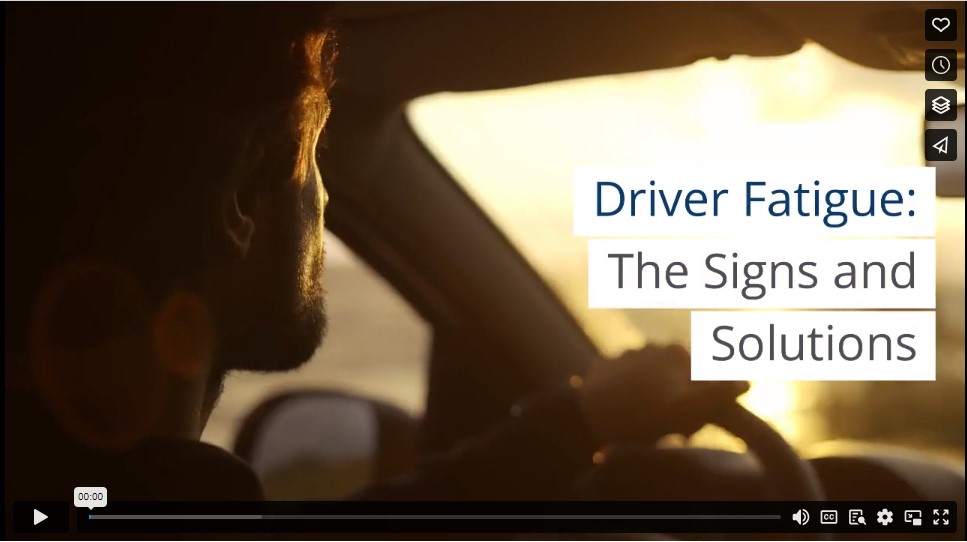Driver Fatigue: The Signs and Solutions
If you’re a truck driver, you know how many hours of sleep you’re supposed to get. But no one told your two-month-old who was up all night with colic. It isn’t the first sleepless night since you brought the baby home, and you know it won’t be the last, but you still have to provide for your family.
How Tired Is Too Tired?
The simple answer is that any time fatigue takes your attention off the road, slows your reflexes, or impairs your judgment you are too tired to operate your vehicle safely.
The CDC reports one in five fatal crashes involve driver fatigue. The average adult needs seven to nine hours of sleep nightly, yet 37% of US workers say they don’t get the recommended amount. Sleepless nights are accumulative, meaning it’s hard to catch up once you get behind. Symptoms increase, making it harder to stay awake the more nights you miss sleep.
Fatigue Symptoms
- You begin to nod off while driving for a fraction of a second to 30 seconds before jerking awake.
- You react slower when road conditions change, including animals running in the road, other drivers cutting you off, or pedestrians stepping into the street. Thinking ahead or driving defensively is hard, and you slam on the brakes more than usual.
- You make poor decisions throughout the day and not just while you are driving.
- You drift out of your lane.
- You experience “tunnel vision.” You don’t notice what’s happening to the side or behind you.
- You forget part or all of your trip and drive on “autopilot.”
To give you an idea of how quickly sleeplessness can impair your driving, consider these facts. After twelve hours without sleep, they estimate you’re driving as impaired as someone with a blood alcohol level of .05. After 24 hours, you’re comparable to someone with a blood alcohol level of .1. The legal limit for alcohol is between .03 and .08 depending on the state.
What should employees do?
- Sleep: Employers can ensure drivers are off long enough to get enough sleep between shifts. However, it’s up to the driver to schedule their downtime so they get the rest they need. Unfortunately, like a new baby, life can cause sleep disruptions. (Note: If you leave an hour early for work, you may find it more restful to take a nap away from home before your shift begins.)
- Teamwork: Watch out for each other. An impaired driver may not recognize their symptoms as fatigue. It’s as essential to stop an overly tired driver from getting behind the wheel as it is to prevent drunk driving. You don’t want them nodding off and drifting into oncoming traffic.
- Medical Attention: If you’re getting seven or more hours of sleep and are still tired throughout the day, it’s time for a DOT physical and probably a sleep study. It measures your sleep patterns and oxygen levels to tell you if you have sleep apnea or other sleep disorders preventing you from getting the rest you need. Talk to your DOT medical examiner, who will help you find a safe solution.
- Medicine: Your medical provider may prescribe something to help you sleep, but read the information that comes with the drug and follow it and your provider’s guidelines. If it says not to drive for eight hours, then make sure you take the medication well before your shift so you can sleep eight hours before getting ready for work. Going to work while the drug is still active is as bad as driving drunk. The same thing goes for any other medications you take.
- Environment: We are creatures of habit. If you routinely sleep at the same time of night in a cool, dark room and avoid your electronics, you can train your body to shut down in the evening close to your bedtime.
- Coffee: If you feel fatigued while driving, studies show that a cup of coffee immediately followed by a 15-30 minute nap will revive you, but the effect is temporary. The only cure for fatigue is sleep.
How can employers help?
- Naps: Employers can allow workers to rest or nap on extended shifts. An hour break for meals will enable employees to catch some Zs and recharge so they’re back on their A-game for the second half of the shift. Doing so can help prevent accidents both in the workplace and on the road.
- Training: They can offer training to employees that will help them recognize when they are impaired and how to recognize the signs in their fellow employees.
- Environment: Foster an environment that encourages operators to speak up if they’re too tired to drive safely. Where possible, be flexible with their hours. Adjusting work hours to accommodate a short nap before a shift may prevent accidents, protecting your employees, business, and community.
As a culture, we have come to accept sleepiness as a state of being. We sometimes allow it to be a badge of honor, bragging about how little sleep we’ve had. However, driving tired is nothing to be proud of and certainly shouldn’t be continued. Finding ways to make sure drivers are well-rested and alert on the road is the only way to ensure the safety of everyone. It should be a top priority for all.
Video

Infographic
As a truck driver, you’re familiar with the recommended hours of sleep. But fatigue can still affect you, leading to distractions, slowed reflexes, and impaired judgment on the road. Find solutions to driver fatigue in this infographic.


